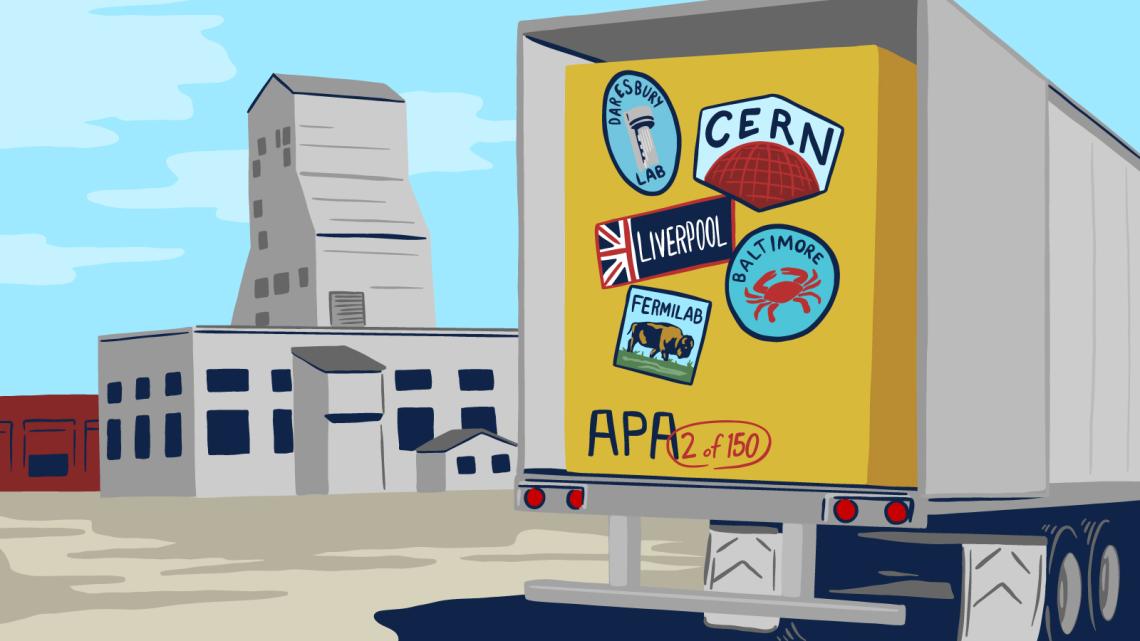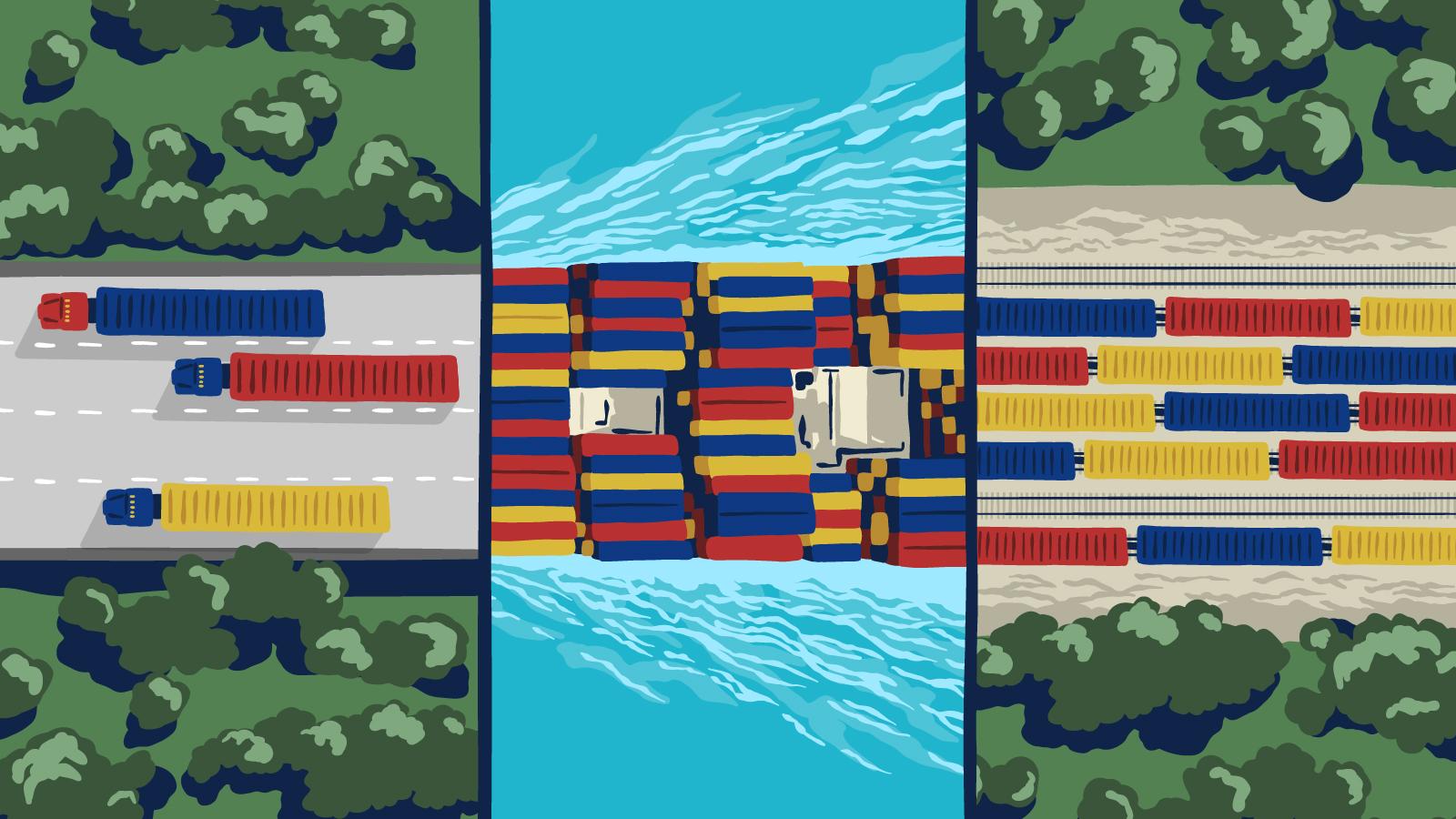On a late-September day, in the high-bay building of Daresbury Laboratory in the United Kingdom, Jeremiah Holzbauer found himself with a problem: Gallons of water from an overnight downpour had unexpectedly collected in the lifting pockets of a 14-ton concrete block he was responsible for getting from Chicago to Daresbury and back. Apparently, the two overlapping tarps used to cover the block’s custom transportation frame were insufficient defense against the elements.
The team at Daresbury Lab had one day to disassemble the frame, examine its condition and the condition of its concrete cargo, then reassemble it all and send it back to Chicago. If rain had penetrated during the first leg of the trip, Holzbauer wanted to see if it would happen again during the return—but first, he had to get this rainwater out. He had nothing on hand to bail out the block beyond a small cup. So that’s what he used.
Luckily, and ironically, Holzbauer and his team were in the middle of a “dry” run, a test of the transportation system that they will use to shuttle massive but delicate cryomodules from Daresbury Lab to the US Department of Energy’s Fermi National Accelerator Laboratory in a suburb of Chicago in the United States. There they will be used in a new particle accelerator that will power a huge neutrino experiment.
The concrete block had the dimensions, weight and mounting points of a real cryomodule; each one is 10 meters long and weighs 27,500 pounds, or 12,500 kilograms. The team was transporting it to see how well the frame they built would protect its cargo from shocks, bumps … and weather.
Transportation tests are just one piece of the logistics required for large international particle physics experiments.

The cryomodules will be used to build a new 215-meter-long particle accelerator at Fermilab as part of the Proton Improvement Plan II, or PIP-II, project. Two different types of cryomodules will be provided by PIP-II partners in the UK and France.
PIP-II is the first particle accelerator to be built in the US with significant in-kind contributions from international partners. Institutions from France, India, Italy and Poland are also providing components, including superconducting cavities, electromagnets, radio-frequency power sources and cryomodule components. In addition, all partnering institutions contribute expertise in design, technology and transportation to PIP-II.
“This is as big as it gets,” says Holzbauer, the PIP-II transportation manager at Fermilab. “This is an order of magnitude more complicated than most other projects, logistically, because you’re shipping between India, the EU and the UK. The transports are longer, there’s a lot more handling steps, customs are much more intensive, and the diversity of equipment is quite significant.”
Holzbauer did not expect to undergo a water displacement exercise during their transportation test. But he’ll know to guard against it when he coordinates the real move: He’s replacing the double tarp with a custom-made single cover.
Holzbauer handles the engineering side of transportation, while the day-to-day logistics are coordinated by PIP-II’s logistics manager at Fermilab, Brian Niesman.
Niesman oversees all PIP-II pieces going in and out of the lab. Most completed components will arrive at Fermilab between 2024 and 2028, but—as exhibited by the cryomodule transport frame—the PIP-II team is already preparing by conducting transportation tests for some of the bigger, more unusual components.
Destination: South Dakota
The particle beam enabled by PIP-II will be sent 800 miles through the earth to the Deep Underground Neutrino Experiment, or DUNE, which will comprise an enormous detector 1.5 kilometers underground at the Sanford Underground Research Facility, or SURF, in South Dakota. DUNE will be the most comprehensive neutrino experiment in the world when it starts operating in 2028. DUNE scientists will use data from neutrino collisions to attempt to learn why the universe is matter-dominated, among other scientific goals.
The experiment itself is an even more international effort: Over 1,400 scientists and engineers in more than 35 countries are part of the DUNE collaboration.
The DUNE collaboration comprises more than 10 consortia that are responsible for the production of specific components and systems for the detector, such as photon detectors. The lead institution for each consortium is responsible for the logistics of these partnerships. LBNF/DUNE-US logistics manager Ladia Jakubec is responsible for planning the movement of all components once shipments arrive in South Dakota. He ensures each consortium has the correct information to manage their logistics chain.
Jakubec’s background in commercial shipments helped prepare him for his current position, but he says working to gather the components for a one-of-a-kind scientific experiment is a singular experience. Where shipments of products for large retailers were typically packed in standard cargo containers that could stack and be moved easily, DUNE components are unique sizes and shapes that cannot be placed in conventional containers.
“With a scientific project, these [pieces] are all one-offs,” he says. “You have to develop the logistics chain of custody for that specific piece and then execute it.”
Jakubec and other DUNE collaborators recently tried this successfully for DUNE’s anode plane assemblies, or APAs. The biggest, most expensive and most fragile components of DUNE’s Far Detector, APAs are 6-by-2.3-meter steel monoliths wrapped in a mesh of 15 miles of hair-thin copper-beryllium wires. They will be responsible for collecting the data from neutrino collisions.
Like the cryomodules, the APAs for the detector will be produced at Daresbury Lab. So, the DUNE team had to figure out how to get the APAs from the UK to South Dakota safely, efficiently and on budget.
Olga Beltramello, a mechanical engineer at CERN and head of the compliance office for DUNE, led the design of a frame to transport two APAs at a time. An expert in dynamics, Beltramello calculated all of the different ways the frame could be bumped or rattled on trains, freight carriers, and trucks, on both European and American roads.
Beltramello has a background in aerospace engineering. She was formerly with the European Space Agency, where she designed satellites to withstand the vibrations and various heavy loading during the launching phase. She says the experience has helped prepare her for her current task. “It’s true that it’s like we are transporting a satellite; it is the same type of fragility,” she says.
Beltramello and her colleagues from Fermilab, SURF, CERN and the Manchester University recently tested the APA frame and transportation system in a trial shipment of two prototypes. Similar to the PIP-II test shipment, the APAs needed to get between Daresbury Lab and Fermilab. To start, the DUNE transportation team shipped the pair from Daresbury Lab to CERN, where they installed them in Beltramello’s prototype frame outfitted with shock absorbers and sensors. The team then sent the APAs by train to Liverpool, UK, by ship to Baltimore, US, and by covered truck to Fermilab and then SURF.
The test validated the transportation system, but it also exposed challenges that Beltramello, Jakubec and others must address. For example, at the port in Baltimore, they had difficulty controlling the cargo transfer from the shipping vessel onto a tractor trailer. The cargo arrived in good condition, but the team’s sensors registered excessive forces during the port handling, which must be addressed for future shipments.
Later this year, the DUNE team will start shipping real APAs. From Daresbury Lab to SURF, the journey should take three to four weeks, including 10 days at sea. Through 2027, they will send 150 APAs to South Dakota in 35 transports.
There will be even more logistical challenges once the detector is built: It will take an enormous amount of planning and coordination to get the vast amounts of liquid argon required for the experiment down into the underground detectors.
But the team is already working on those logistics.
Holzbauer is on a Fermilab panel where he is carefully documenting lessons learned for the benefit of people managing similar projects. He already used his experience with the cryomodule frame to advise Beltramello on the APA transport system.
“I think this is the model going forward for these projects,” says Holzbauer. “We want it to be a more multinational collaboration. We want it to be something where the world can contribute and help us achieve these large facilities together and participate in the science that comes out of it.”







